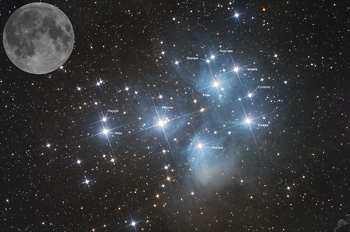 |
CHAMÄLEON + ONJALA OBSERVATORY DeepSky | SITEMAP HOME CHAMÄLEON |
|
 |
|||
| « back to overview Cluster | Load
higher resolution (1800 x 1200 Pixel 3500 x 2300 Pixel) |
Object description |

Messier 45 (Collinder 42) the Pleiades - also called the Atlantids, Atlantiades, Pleiades or the Seven Sisters - is an open star cluster which is already visible to the naked eye in the constellation Taurus. In the Messier catalog it has the designation M 45. The star cluster is named after figures of the Greek mythology.
The Pleiades are one of the few objects in the sky that were known to mankind long before the invention of the telescope and therefore they are part of the folklore and myths of many cultures on our planet. Galileo Galilei was probably the first observer to look at the Pleiades through a telescope. He published his observation with a sketch of the cluster of 36 stars in March 1610 in his essay "Sidereus Nuncius".
The 7 brightest stars are named after figures of Greek mythology, the Titan Atlas (therefore also Atlantides), his wife Pleione and their seven daughters Alkyone, Asterope, Celaeno, Elektra, Maia, Merope and Taygete. The Pleiades, who belong to the group of the nymphs, educated Dionysus and Zeus together. According to mythology, they were pursued by the celestial hunter Orion. Zeus moved the Pleiades to the sky as a constellation, but even there they are still pursued by Orion, whose constellation is located about 30° southeast of the Pleiades.
The NGC catalog does not list the Pleiades separately as a single object, but there are some reflection nebulae in the area of the cluster with their own NGC numbers. These include the Maja Nebula (NGC 1432) and the Merope Nebula (NGC 1435). Only about half a minute of arc from Merope is a concentration of interstellar dust known as IC 349 or Barnard's Merope Nebula.
The Pleiades, with an extent of about 2°, appear about four times the size of the Moon as seen with the naked eye. The star cluster lies nearly 445 light-years away from the solar system and contains at least 1200 stars which are on average about 125 million years old. Thus it is one of the youngest open star clusters in our Milky Way and due to its proximity to the solar system also one of the best explored. The true diameter is about 40 lightyears, the core of bright stars about 10 lightyears.
 |
The
blue nebulae surrounding the bright Pleiades stars are not the remnants - as
previously long suspected - of gas and dust from which the stars were formed.
The star cluster is currently passing through a molecular cloud known as the
Taurus-Auriga dark nebula complex. The original
remnants of dust and gas that would have remained after the Pleiades stars
formed would have completely dissolved in long ago due to the enormous
radiation pressure from the stars. The Pleiades Nebulae are reflection nebulae, reflecting and scattering light from the hot blue cluster stars. Only south of Merope a slightly reddish coloration of the nebula becomes visible, indicating that there the strong UV radiation of the stars ionizes the surrounding gas. A wide angle view from us of the Pleiades is shown here. « Click here or the thumbnail to load a large annoted image and a size comparison to the full moon. |
 |
 |
 |
 |
 |
 |
 |
| Sun | Moon | Solar System | DeepSky | Widefield | Miscellaneous | Spec. Projects |